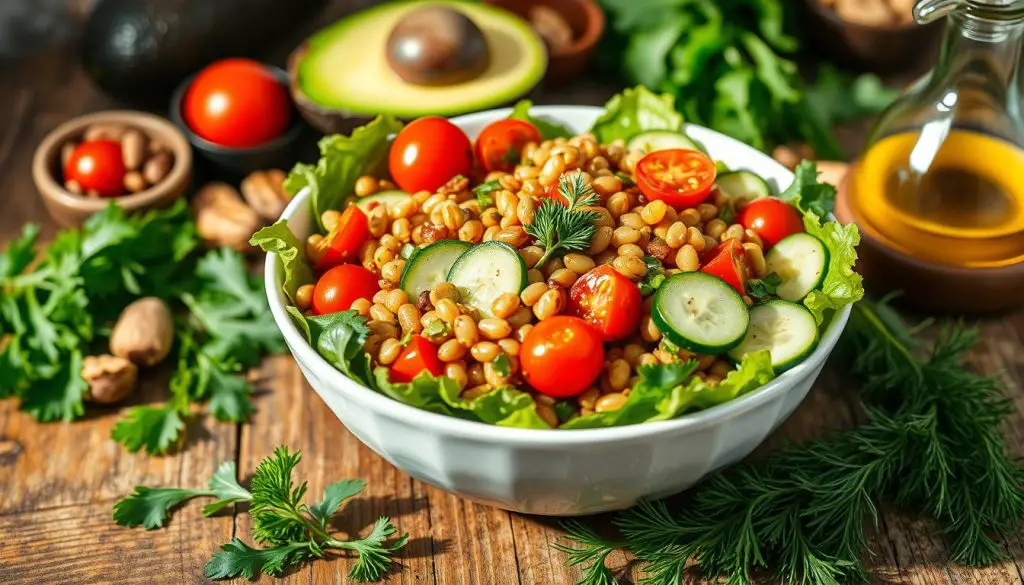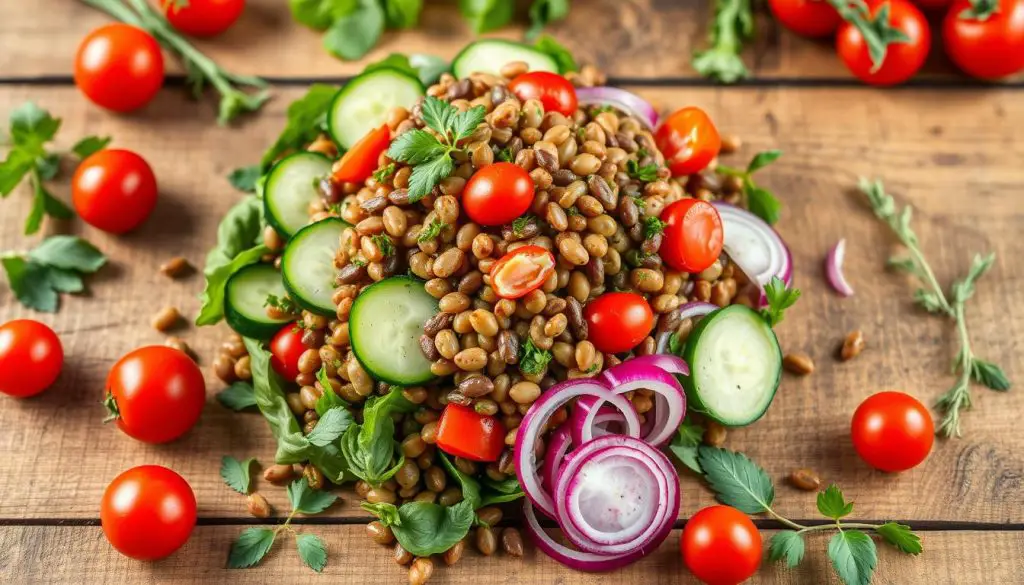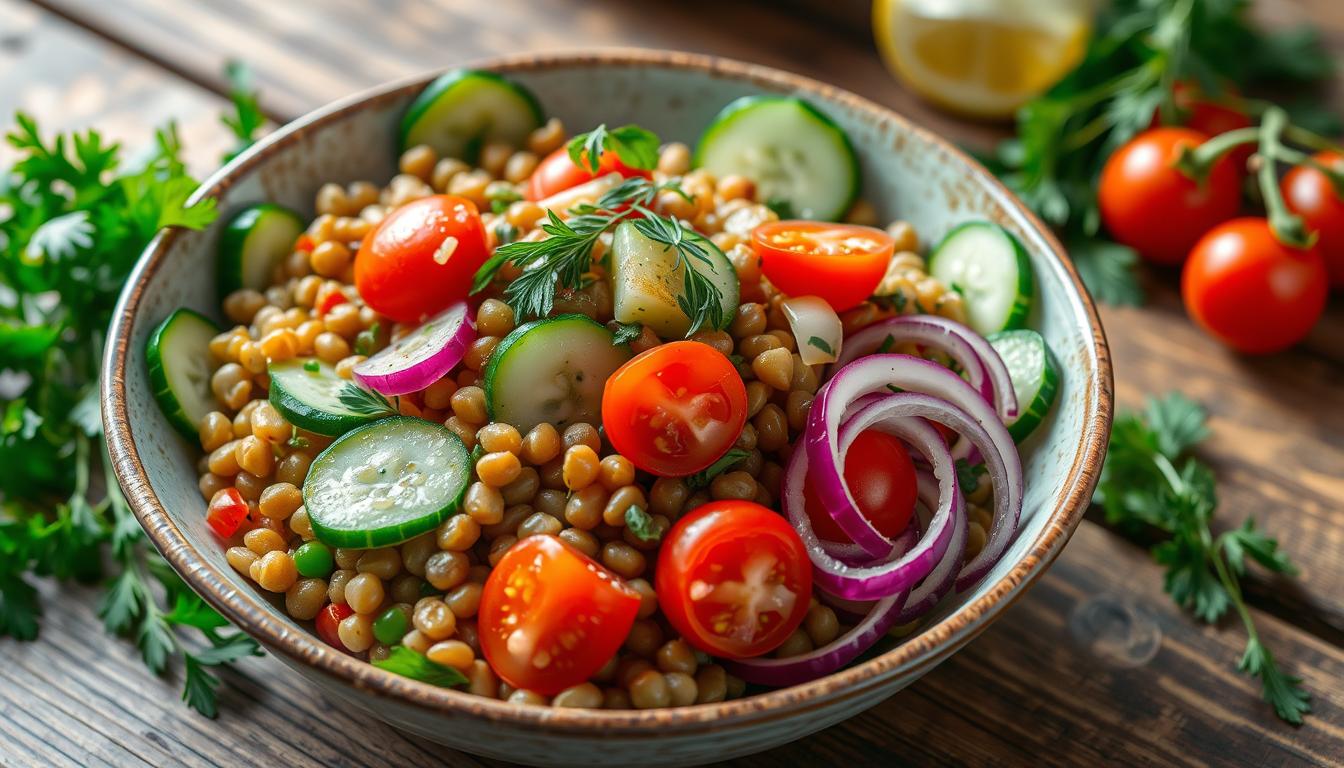Do you live with fibromyalgia’s tough symptoms? Ever thought a tasty salad could help with your chronic pain? Get ready to be amazed by a lentil and cucumber salad that could be your new favorite dish for fibromyalgia relief.
7 out of 7 recent clinical trials show that diet can really help with fibromyalgia pain and function. The right foods, full of nutrients and anti-inflammatory powers, can fight fibromyalgia’s pain, tiredness, and brain fog. Let’s explore how this lentil and cucumber salad can change how you manage fibromyalgia.
The Power of an Anti-Inflammatory Diet for Fibromyalgia
Inflammation is a big problem in many chronic health issues, like fibromyalgia. An anti-inflammatory diet can help manage this complex condition. By choosing foods that fight inflammation, you can ease the daily challenges of fibromyalgia.
Reducing Inflammation Through Food Choices
Starting an anti-inflammatory diet for fibromyalgia means cutting out foods that cause inflammation. This includes gluten, refined sugar, dairy, caffeine, and alcohol. These foods can make your symptoms worse. Instead, eat foods like beans, avocado, and dark leafy greens, which are good for you.
The Benefits of a Plant-Based, Nutrient-Dense Approach
Eating a plant-based, nutrient-rich diet is key for managing fibromyalgia. It gives your body the vitamins, minerals, and antioxidants it needs. Studies show that diets like the Mediterranean Diet can improve pain, fatigue, and overall life quality.
By eating a variety of anti-inflammatory, fibromyalgia-friendly foods, you can fight chronic inflammation. This helps you take back your health and well-being.
Lentil and Cucumber Salad for Fibromyalgia: A Nutritious Delight
For those with fibromyalgia, finding good food can really help. A lentil and cucumber salad is a great choice. It’s packed with protein, fiber, and anti-inflammatory ingredients.
Lentils are full of plant-based proteins. They have lots of amino acids. They also have fiber, which helps with digestion and feeling full. Plus, they have folate and magnesium, important for managing fibromyalgia symptoms.
Cucumbers add to the salad’s benefits. They’re hydrating and have compounds that fight inflammation. This salad is perfect for reducing fibromyalgia pain and discomfort.
To make this fibromyalgia-friendly recipe, you’ll need:
- 1 cup cooked lentils
- 1 cup diced cucumbers
- 1/2 cup chopped red onion
- 2 tablespoons chopped fresh parsley
- 2 tablespoons olive oil
- 1 tablespoon lemon juice
- Salt and pepper to taste
Just mix all the ingredients in a bowl. Toss gently and enjoy. The lentils give you protein, and the cucumbers and other ingredients add freshness and fight inflammation. This lentil and cucumber salad is great for your fibromyalgia management plan. It gives your body the nourishment it needs to feel better.
The Virtues of Salmon for Fibromyalgia Management
If you’re living with fibromyalgia, adding salmon to your diet can change your life. This fish is full of omega-3 fatty acids and protein. Omega-3s are known for their strong anti-inflammatory effects, which can reduce fibromyalgia pain and discomfort.
Omega-3s and Protein: Powerful Allies
Salmon also has a lot of protein, which is great for muscle health and recovery. People with fibromyalgia often have weak muscles and feel tired. Eating salmon can help manage your symptoms and boost your health.
It’s easy to cook salmon. Just roast it in the oven. Set your oven to 400°F (200°C). Line a baking sheet with parchment paper and put your salmon on it. Add olive oil, salt, pepper, and herbs, then bake for 12-15 minutes. When it’s done, it will flake easily with a fork. This simple method makes it easy to add this superfood to your meals.
By eating salmon, you can use omega-3s and protein to fight fibromyalgia symptoms. Try different easy cooking methods to find your favorite way to enjoy this healthy fish.
Rose Water: A Secret Ingredient for Anti-Inflammatory Smoothies
Discover the magic of rose water in your smoothies! This fragrant ingredient can turn your homemade drinks into soothing treats. They support those with fibromyalgia.
Rose water is more than a flavor enhancer. It has strong anti-inflammatory properties. These can help ease fibromyalgia symptoms. Adding rose water to your anti-inflammatory smoothies brings a refreshing taste and natural benefits.
To make a tasty rose water smoothie, try blending:
- Frozen berries (like strawberries, raspberries, or blackberries) for antioxidants and anti-inflammatory effects
- Leafy greens like spinach or kale for vitamins and minerals
- A spoonful of rose water for a floral touch
- A protein source, like Greek yogurt or plant-based milk, for energy
- A bit of honey or maple syrup for sweetness
Blending these natural anti-inflammatory ingredients makes a delicious, nourishing homemade smoothie recipe. It may help ease fibromyalgia symptoms. Try rose water in your anti-inflammatory smoothies for its benefits.

Fibromyalgia Syndrome: Breaking the Cycle
Fibromyalgia is a complex condition that can greatly impact daily life. It affects aspects like chronic pain, fatigue, and cognitive issues. Knowing the common signs and symptoms is key to managing this challenging condition effectively.
Common Signs and Symptoms
People with fibromyalgia face a range of debilitating symptoms. These include:
- Widespread musculoskeletal pain that can be dull, aching, or burning in nature
- Persistent fatigue that is not alleviated by rest
- Sleep disturbances and unrefreshing sleep
- Cognitive difficulties, such as problems with memory, concentration, and attention
- Tender points throughout the body that are sensitive to touch
- Headaches, including migraines or tension-type headaches
- Digestive issues, such as irritable bowel syndrome (IBS)
These symptoms can vary, making it hard to manage the condition. Breaking the cycle of chronic pain and fatigue is key to improving life for those with fibromyalgia syndrome.
| Symptom | Prevalence | Impact on Daily Life |
|---|---|---|
| Widespread pain | 90% of individuals with fibromyalgia | Significant reduction in physical function and mobility |
| Fatigue | 78% of individuals with fibromyalgia | Decreased energy levels and ability to perform daily tasks |
| Sleep disturbances | 95% of individuals with fibromyalgia | Impaired cognitive function and overall well-being |
| Cognitive issues | 70% of individuals with fibromyalgia | Difficulty with memory, concentration, and decision-making |
To tackle fibromyalgia, a holistic approach is recommended. This includes physical therapy, rehabilitation, and lifestyle modifications. Working with healthcare professionals can help manage symptoms and improve life quality.
The Role of Physical Therapy in Fibromyalgia Treatment
Physical therapy is key in managing fibromyalgia symptoms. It’s a non-drug way to tackle the condition. It helps with pain management, muscle strengthening, cardiovascular fitness, and manual therapy.
Cardiovascular fitness training is a big part of physical therapy for fibromyalgia. It uses low-impact exercises like walking, swimming, or cycling. This helps improve endurance and energy, which are often low in people with fibromyalgia.
- Stretching and manual therapy techniques, like myofascial release, ease muscle tension. They also improve flexibility, which is important for managing pain.
- Postural re-education exercises help with posture and body mechanics. This can reduce musculoskeletal pain and fatigue.
- Strengthening exercises target specific muscles. They help improve physical function and make daily tasks easier.
Adding physical therapy to a treatment plan for fibromyalgia can help a lot. It can reduce pain, improve physical function, and enhance quality of life. Physical therapy works well with other treatments like medication and lifestyle changes. Together, they offer a complete approach to managing fibromyalgia.

Nutrition Tips for Fibromyalgia: Foods to Avoid
A diet rich in nutrients and low in inflammation is key for managing fibromyalgia. It’s also vital to know which foods can make symptoms worse. By avoiding these foods, you can help reduce inflammation and feel better.
Here are some foods and drinks that people with fibromyalgia should avoid:
- Caffeine: Found in coffee, tea, and some fizzy drinks, caffeine can mess with your sleep. It can also make pain and tiredness worse.
- Carbonated beverages: Drinks with carbonation and artificial sweeteners can cause bloating and stomach problems.
- Alcohol: Alcohol can make fibromyalgia symptoms like pain, tiredness, and brain fog worse.
- Processed foods: Foods full of additives, preservatives, and unhealthy fats can trigger inflammation and make symptoms worse.
Some people with fibromyalgia may also find that chocolate, citrus fruits, and dairy products can make their symptoms worse. It’s important to listen to your body and find out which foods you’re sensitive to. This way, you can create a diet plan that helps you recover.
| Food/Beverage | Reason for Avoidance |
|---|---|
| Caffeine | Disrupts sleep patterns and contributes to increased pain and fatigue |
| Carbonated beverages | Cause bloating and gastrointestinal distress |
| Alcohol | Worsens symptoms of pain, fatigue, and brain fog |
| Processed foods | High in additives, preservatives, and unhealthy fats that can trigger inflammation |
Remember, everyone’s body is different. It’s important to try different foods and find what works best for you. By avoiding these trigger foods and eating a healthy, anti-inflammatory diet, you can manage your fibromyalgia symptoms better. This can improve your overall quality of life.
The Importance of a Balanced Diet for Fibromyalgia
Eating a balanced diet is key for those with fibromyalgia. It helps support your health and manage symptoms. Focus on whole, unprocessed foods in your meals.
A balanced diet helps fix vitamin and mineral gaps. People with fibromyalgia might lack certain nutrients. This can worsen symptoms and hurt the immune system. Eating foods rich in nutrient-dense foods ensures your body gets what it needs.
Also, a balanced diet boosts energy. Fibromyalgia often leads to tiredness. Eating foods like complex carbs, lean proteins, and healthy fats can increase energy. This improves your overall health.
Lastly, a balanced diet can reduce inflammation. This is common in fibromyalgia. Foods high in omega-3 fatty acids can help manage inflammation. This might ease your symptoms.
Remember, a balanced diet is tailored to each person. Work with your healthcare team to find the right diet for you. By choosing the right foods, you can manage fibromyalgia better and live a better life.

Carbonated Beverages and Fibromyalgia: A Cautionary Tale
Managing fibromyalgia means watching out for certain drinks. Soda and some juices can be tricky for people with this condition.
Drinks like soda can take phosphorus from your bones. This is bad because it weakens bones and raises the risk of osteoporosis. For those with fibromyalgia, this can make pain and fatigue worse.
Caffeine in these drinks can also cause dehydration. Dehydration makes fibromyalgia symptoms worse. It also stresses the adrenal glands, which help handle stress.
To stay healthy and manage fibromyalgia, cut down on carbonated drinks. Drink water, herbal teas, and other non-caffeinated, non-carbonated drinks instead. These choices help your body and overall health.
Choosing the right drinks is a big step in fighting fibromyalgia. Every change you make can help your health and improve your life.
The Impact of Processed Foods on Fibromyalgia
Living with fibromyalgia means what you eat matters a lot. Processed foods can make your pain, fatigue, and inflammation worse. These foods often have additives and preservatives but lack the nutrients your body needs.
Identifying Food Sensitivities and Triggers
Managing fibromyalgia through diet starts with finding out what foods bother you. A food diary can help you see patterns between what you eat and how you feel. This knowledge helps you choose better foods for your meals.
- Notice how your body reacts to certain foods, like more pain, tiredness, or stomach issues.
- Try removing suspected trigger foods from your diet for a few weeks and see if your symptoms get better.
- Then, add back the foods you removed one at a time to find out which ones are the problem.
By figuring out your food sensitivities and inflammatory triggers, you can lessen the bad effects of processed foods on your fibromyalgia symptoms.

Managing fibromyalgia through diet is a process that takes time and patience. Be kind to yourself, and don’t be afraid to ask for help from a healthcare expert who knows about nutrition and chronic pain.
Low-Carb, High-Protein Diets for Fibromyalgia Management
If you have fibromyalgia, trying a low-carb, high-protein diet might help a lot. It can keep your blood sugar steady, which means less hunger and more energy. Eating foods rich in protein and nutrients can also help you manage your weight and mood better.
This diet can help with reactive hypoglycemia, a big problem for people with fibromyalgia. It’s when blood sugar drops too low, causing tiredness, brain fog, and other bad symptoms. By eating fewer simple sugars and carbs, you can avoid these drops and feel better.
| Nutrient | Benefits for Fibromyalgia |
|---|---|
| Protein | Helps build and repair muscle, supports energy production, and can enhance feelings of satiety. |
| Healthy Fats | Reduce inflammation, support brain function, and provide a steady source of energy. |
| Fiber | Promotes gut health, regulates blood sugar levels, and can alleviate digestive issues. |
Keep in mind, everyone reacts differently to a low-carb, high-protein diet. Some people with fibromyalgia find it helps a lot, while others might not. Always talk to a doctor before changing your diet. They can help you find the best foods for your specific needs.
Balancing Macronutrients for Optimal Fibromyalgia Management
When you’re on a low-carb, high-protein diet, make sure you get the right mix of nutrients. Focus on lean proteins, low-glycemic carbohydrates, and anti-inflammatory fats. This balance is key to feeling your best and managing fibromyalgia symptoms.
Incorporating Raw Foods into Your Fibromyalgia Diet
Living with fibromyalgia can be tough. But adding raw, enzyme-rich foods to your diet might change everything. These foods are packed with nutrients and can help your body heal. They can also ease some of the tough symptoms of this chronic condition.
Begin your day with a fresh fruit or a raw veggie like an apple, carrot, or celery. These foods give you energy and nourishment right away. For lunch, try a raw salad with leafy greens, colorful veggies, and a bit of flaxseed oil. This meal fights inflammation and gives your body the vitamins and minerals it needs.
Raw foods can bring many benefits to your fibromyalgia diet. They improve digestion, boost energy, and help manage pain. By adding more raw foods to your diet, you can help your body heal. This can greatly improve your quality of life.
Source Links
- https://brianbarr.co.uk/about/blog/anti-inflammatory-recipes-for-fibromyalgia-sufferers/
- https://www.paincation.com/seeking-relief-from-fibromyalgia-through-diet-a-hopeful-path-in-a-sea-of-doubts-rss/
- https://www.eatingwell.com/gallery/8054740/anti-inflammatory-high-fiber-lunches/
- https://www.healthline.com/nutrition/mind-diet
- https://nourishingmeals.com/
- https://www.healthline.com/health/food-nutrition/Mediterranean-diet-recipes
- https://www.mamanatural.com/poop-chart/
- https://themaplecenter.org/newsletter-article-index/
- https://www.healthline.com/nutrition/primal-diet
- https://nourishingmeals.com/2010/01/elimination-and-detoxification-diet-its-about-feeling-good
- https://www.medicalnewstoday.com/articles/325352
- https://www.healthline.com/nutrition/dr-sebi-diet
- https://dokumen.pub/the-anti-inflammation-cookbook-the-delicious-way-to-reduce-inflammation-and-stay-healthy-1st-edition-1452139881-9781452139883-1452147191-9781452147192.html
- https://www.healthline.com/nutrition/foods-that-cure-fissures
- https://restormedicine.com/wp-content/uploads/woocommerce_uploads/2023/06/ebook-dbjlbc.pdf
- https://www.orangevillenaturopath.com/blog
- http://ndl.ethernet.edu.et/bitstream/123456789/36842/1/3125.pdf
- https://www.healthline.com/health/managing-osteoporosis/7-day-osteoporosis-diet-plan
- https://www.healthline.com/nutrition/22-high-fiber-foods
- https://www.healthrising.org/blog/2013/09/23/glycemic-index-diet-right-chronic-fatigue-syndrome-fibromyalgia/
- https://www.healthline.com/nutrition/foods-high-in-lectins
- https://www.medicalnewstoday.com/articles/321683
- https://www.julienutrition.com/nutrition-tips-ramadan/
- https://www.vaidyagrama.com/articles.html
- https://threestonehearth.com/everything
- https://locations.seniorshelpingseniors.com/nc/wakeforest/blog-109.html
- https://www.everydayhealth.com/diet-nutrition/gluten-free-diet/
- https://www.medicalmedium.com/blog/truth-about-protein
- https://www.healthline.com/nutrition/gerson-therapy
- https://www.sharecare.com/diet-nutrition/healthy-eating-tricks
- https://www.drtereo.com/blog/recipes-for-health-
